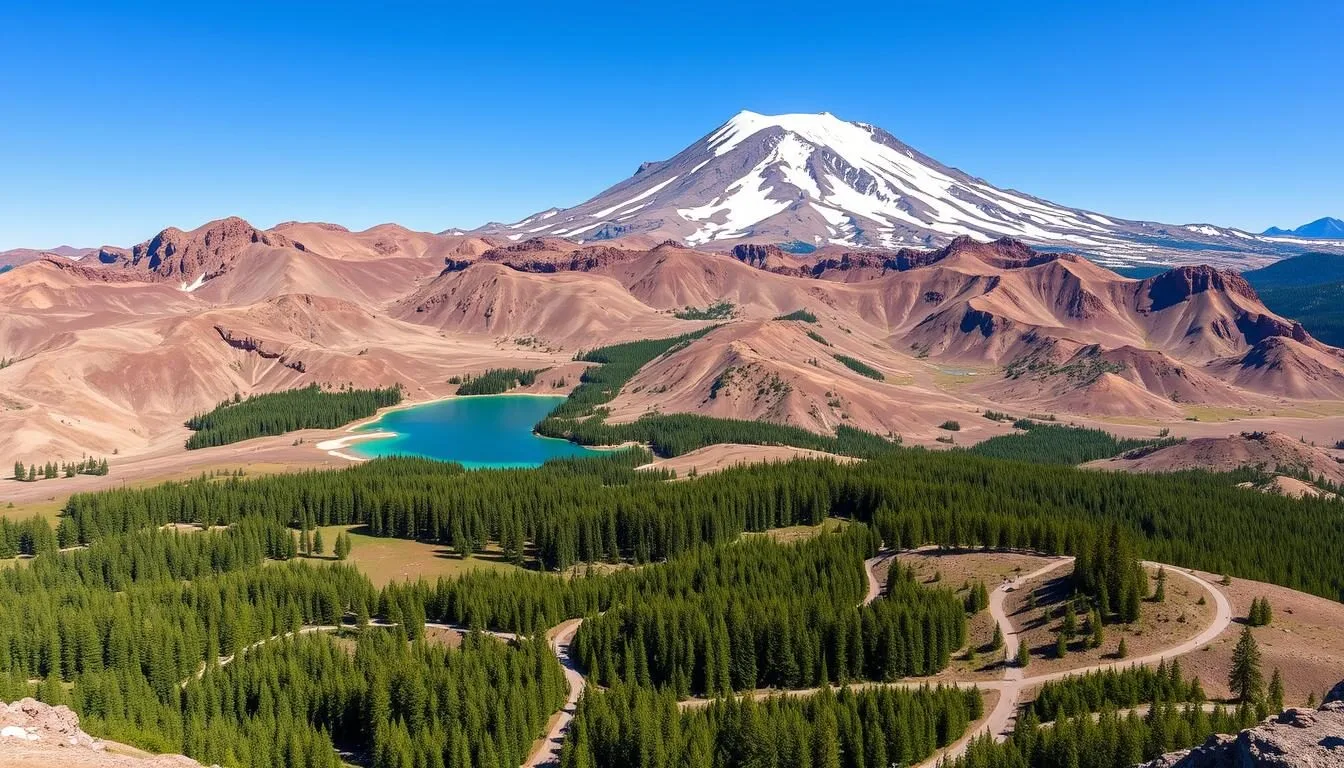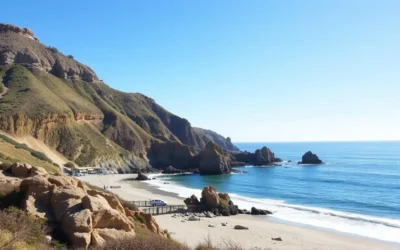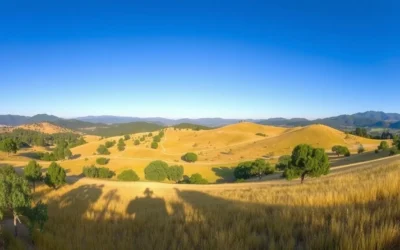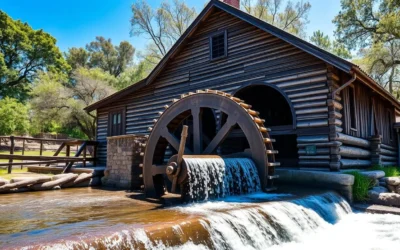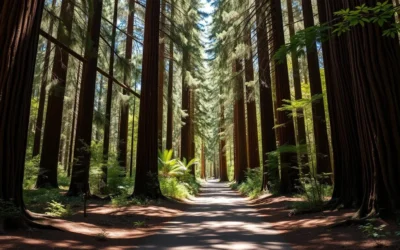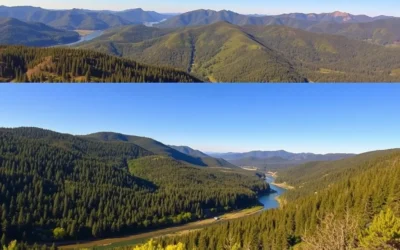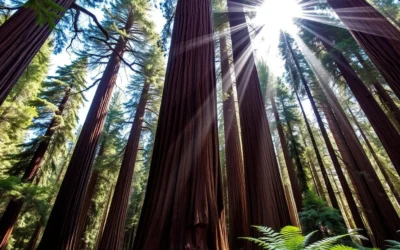✓ Accommodations✓ Flights✓ Rental Cars
Nestled in the heart of Northern California lies a natural wonder that calls to adventure seekers and nature lovers alike. Lassen Volcanic National Park is a unique destination that offers an unforgettable journey through its volcanic landscapes and serene environments.
With over 10,400 feet elevation at its highest point, this volcanic national park is home to one of the largest plug dome volcanoes in the world. As you explore the park, you’ll encounter mesmerizing hydrothermal areas, beautiful meadows, and abundant wildlife.
Unlike more crowded national parks in California, Lassen Volcanic provides a peaceful experience with plenty of space to explore and connect with nature. Whether you’re looking to conquer volcanic peaks or relax by crystal-clear alpine lakes, this park has something for every type of outdoor enthusiast.
Discovering the Volcanic Wonders of Lassen Peak Range
Lassen Volcanic National Park is a testament to the raw power of nature, showcasing an array of volcanic features that have captivated visitors for centuries. As you explore this unique volcanic national park, you’ll discover a diverse range of geological formations that highlight the park’s complex history.
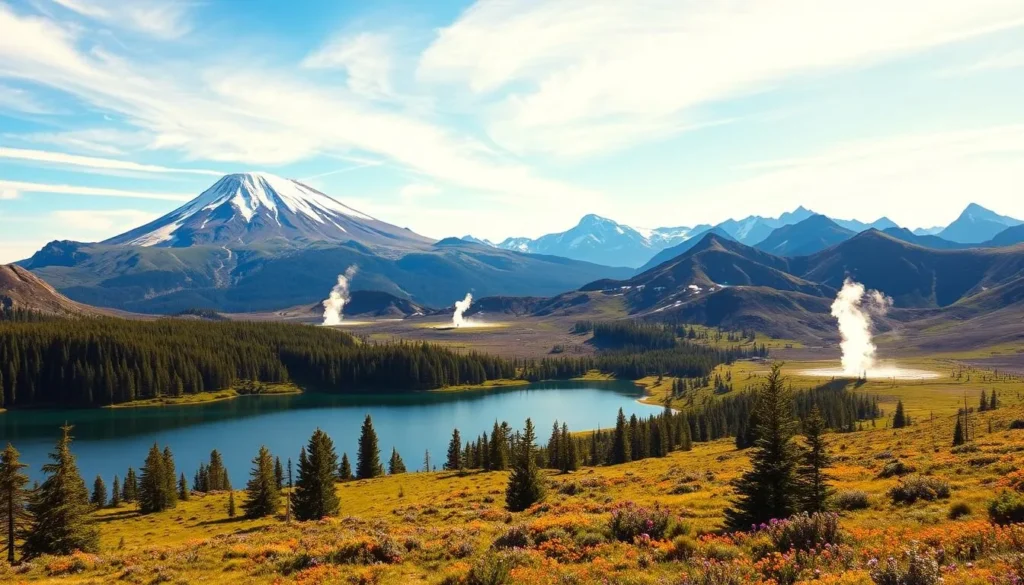
The park’s geological history is a story of continuous activity, with the most recent significant eruption occurring between 1914 and 1917. This period of activity reshaped the landscape dramatically, creating the largest plug dome volcano in the world, Lassen Peak.
The Geological Marvel of Northern California
Lassen Volcanic National Park is part of the Cascade Range, a chain of volcanoes stretching from British Columbia to Northern California. The park’s volcanic landscape features all four types of volcanoes: shield, composite, cinder cone, and plug dome. This diversity makes it a unique geological classroom, where visitors can learn about the different types of volcanic activity.
| Volcano Type | Description | Notable Features |
|---|---|---|
| Shield | Gently sloping volcano | Lava flows |
| Composite | Steep, conical volcano | Explosive eruptions |
| Cinder Cone | Small, steep volcano | Built from accumulated ash |
| Plug Dome | Volcano with a distinctive dome shape | Lassen Peak, a prominent example |
The park’s elevation ranges from 5,650 feet to 10,457 feet at Lassen Peak’s summit, creating diverse microclimates and ecosystems throughout the mountain terrain. Geologists continue to study the area for its valuable insights into volcanic activity and earth science, making it not just beautiful but scientifically significant.
As you explore Lassen Volcanic National Park, you’ll be struck by the colorful mineral deposits and striking visual contrasts against the deep blue skies of Northern California. The park’s unique combination of geological features makes it a fascinating destination for anyone interested in the natural world.
The Geological Marvel of Northern California
Lassen Volcanic National Park, established in 1916, is not just a national park but a window into the Earth’s volcanic past, showcasing its power and beauty. As you explore this stunning natural wonder, you’ll discover a rich history that spans thousands of years, from the Native American tribes who first considered the mountains sacred to the early European explorers who were drawn to the region’s natural resources.
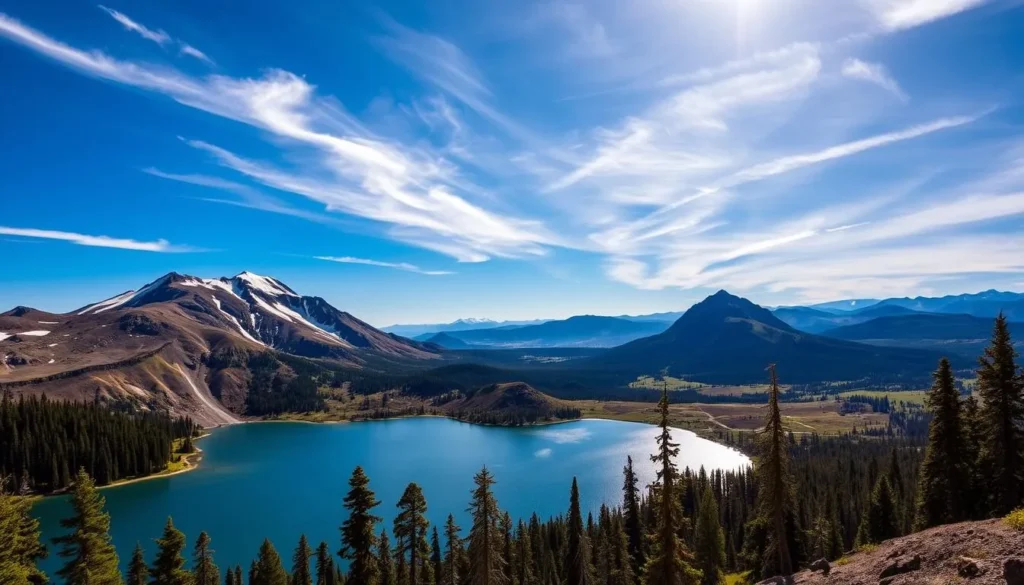
A Brief History of Lassen Volcanic National Park
The story of Lassen Volcanic National Park is one of natural beauty and human fascination. The park was officially established on August 9, 1916, making it one of the earlier national parks in the United States system. This designation was largely prompted by Lassen Peak’s dramatic eruptions between 1914 and 1917, which captured national attention and highlighted the area’s geological significance.
Before becoming a national park, the area was home to several Native American tribes, including the Atsugewi, Yana, Yahi, and Maidu, who considered the mountains sacred. Early European explorers and settlers were drawn to the region’s natural resources, with Peter Lassen, a Danish immigrant, leading settlers through the area in the 1830s, eventually lending his name to the peak.
- The park’s development included significant Civilian Conservation Corps projects during the 1930s, which built many of the trails, campgrounds, and facilities still used today.
- Throughout its history, the park has served as an important scientific research site, helping geologists understand volcanic activity and hydrothermal systems.
- Despite being one of California’s national parks, Lassen has remained relatively uncrowded compared to Yosemite or Sequoia, preserving its wilderness character and providing visitors with a more intimate natural experience.
As you explore Lassen Volcanic National Park, you’ll be immersed in a unique volcanic landscape that includes boiling mud pots, steam vents, and fumaroles, showcasing the Earth’s power. The park spans 100,000 acres and is home to diverse ecosystems and features, including the famous Lassen Peak, one of the biggest plug dome volcanoes globally.
Best Time to Visit Lassen Peak Range
Planning a trip to Lassen Volcanic National Park requires understanding the best times to visit for an optimal experience. The park is open all year, but the accessibility of its roads and trails varies significantly with the seasons.
Seasonal Highlights
The optimal time to visit Lassen Volcanic National Park is from July through September, when most park roads and trails are fully accessible after the winter snow has melted. During this period, you can enjoy hiking and exploring the geothermal areas under warm and dry conditions.
Visiting in the spring (May-June) offers the chance to see wildflower blooms and rushing waterfalls from snowmelt, though many high-elevation trails may still be snow-covered. In the fall (late September-October), the park’s aspen groves display spectacular color changes, with cooler temperatures and fewer crowds, but there’s an increasing chance of early snow.
| Season | Weather Conditions | Activities |
|---|---|---|
| Summer (July-September) | Warm and dry, with temperatures ranging from 70-85°F (21-29°C) during the day and dropping to 40-50°F (4-10°C) at night. | Hiking, exploring geothermal areas. |
| Spring (May-June) | Cool, with snowmelt and potential snow cover on high-elevation trails. | Viewing wildflower blooms, rushing waterfalls. |
| Fall (Late September-October) | Cooler temperatures, with color changes in aspen groves. | Enjoying foliage, hiking with fewer crowds. |
| Winter (November-April) | Cold, with significant snowfall (average of 30 feet annually). | Snowshoeing, cross-country skiing. |
Weather conditions can change rapidly at high elevations, so checking the park’s current conditions before your visit is essential, regardless of the season. The park’s main road, Lassen Volcanic National Park Highway, typically opens fully in late June or early July and begins closing sections with the first significant snowfalls in October.

Seasonal Highlights and Weather Conditions
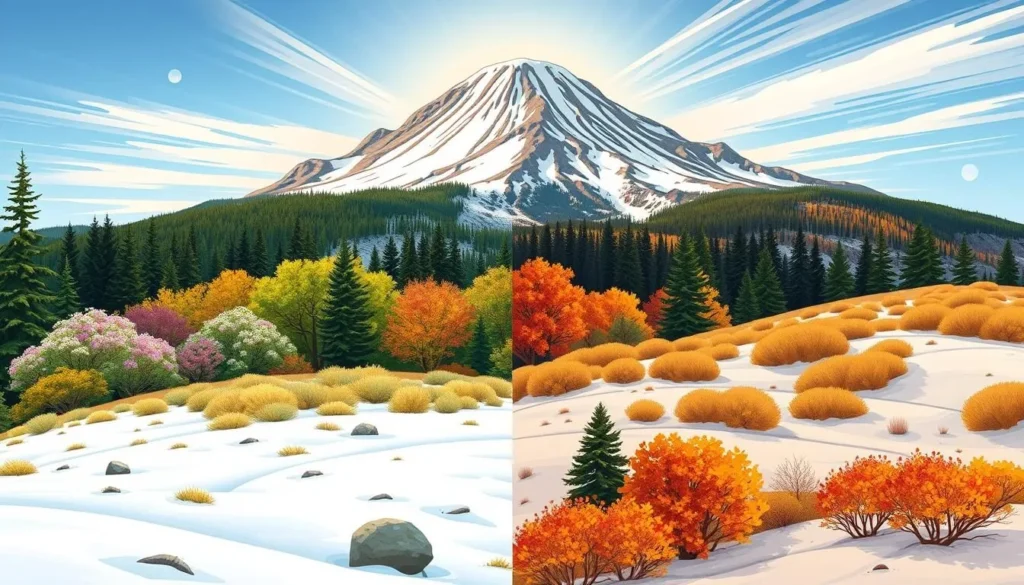
The beauty of Lassen Volcanic National Park is not limited to a single season; it transforms with each change, offering a new adventure every time you visit. The park’s diverse landscapes and activities make it an ideal destination for outdoor enthusiasts year-round.
Peak Season vs. Off-Season Experience
Visiting Lassen Volcanic National Park can be a unique experience depending on the season. During peak season (July-August), the park offers full access to all facilities, trails, and attractions, with comfortable daytime temperatures and all visitor services operating at full capacity.
Some of the highlights of visiting during peak season include:
- Ranger-led programs and evening campfire talks that enhance your understanding of the park’s volcanic features and natural history.
- Special events that take advantage of the warm weather, making it ideal for hiking and exploring.
In contrast, the off-season visits in spring and fall reward you with significantly fewer crowds, allowing for more solitary experiences on popular trails and at major attractions like Bumpass Hell.
Some benefits of visiting during the off-season include:
- Winter transforms the park into a snow-covered wonderland from November through April, offering unique recreational opportunities like snowshoeing and cross-country skiing on marked winter routes.
- The Kohm Yah-mah-nee Visitor Center remains open year-round, providing information and orientation regardless of when you visit.
- Wildlife viewing opportunities vary by season, with spring offering chances to see newborn animals, summer providing the most active wildlife periods, and fall featuring elk and deer during rutting season.
For photography enthusiasts, the shoulder seasons (late spring or early fall) are particularly appealing due to the dramatic lighting conditions and fewer visitors, creating perfect shooting conditions.
Lassen Peak Range, California: Best Things to Do – Top Picks
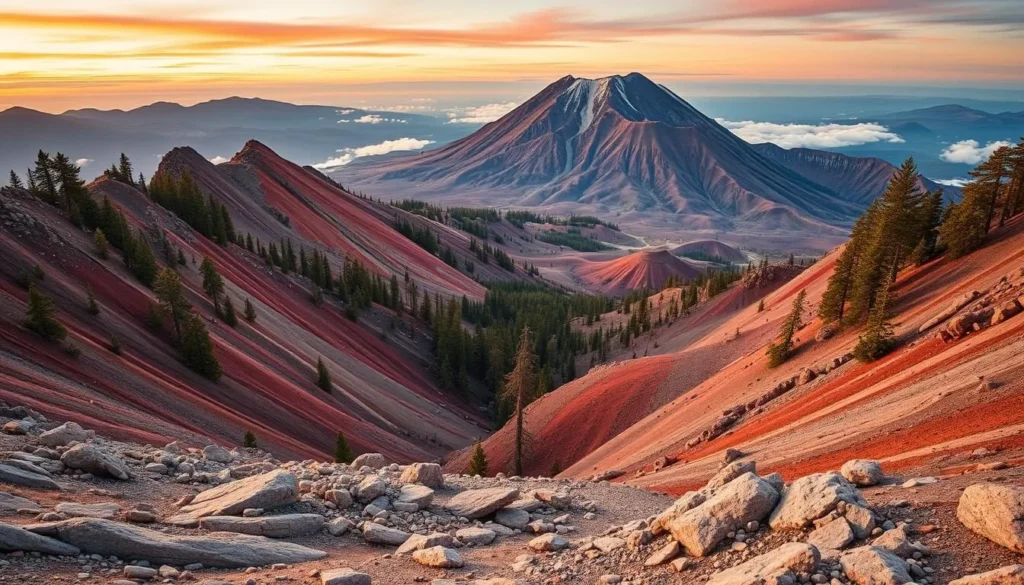
Experience the best of California’s volcanic landscapes at Lassen Volcanic National Park. This gem in California’s heart lets visitors explore a diverse volcanic landscape, making it perfect for outdoor lovers and nature fans.
Overview of Must-See Attractions
Lassen Volcanic National Park is home to numerous attractions that showcase its unique volcanic features. From hiking to the summit of Lassen Peak to exploring the hydrothermal areas, there’s something for everyone.
The park’s centerpiece, Lassen Peak, stands tall at 10,457 feet, offering hikers panoramic views of the surrounding volcanic landscape. On clear days, visibility can extend up to 200 miles.
- Lassen Peak: At 10,457 feet, it offers panoramic views of the volcanic landscape.
- Bumpass Hell: The park’s largest hydrothermal area, featuring boiling mud pots and steaming fumaroles.
- Sulphur Works: Provides an accessible glimpse of the park’s geothermal features.
- Manzanita Lake: Offers reflective views of Lassen Peak and opportunities for fishing and kayaking.
- The Devastated Area: Showcases the destructive power of Lassen’s 1915 eruption.
- Kings Creek Falls: A 40-foot waterfall accessible via a moderate 3-mile round-trip hike.
- Cinder Cone and the Painted Dunes: A unique landscape featuring a perfectly formed volcanic cone and colorful ash deposits.
Each of these attractions offers a unique experience, allowing visitors to fully immerse themselves in the natural beauty and geological wonders of Lassen Volcanic National Park.
Planning Your Itinerary for Maximum Experience
As you plan your visit to Lassen Volcanic National Park, you’ll want to make the most of your time exploring this incredible volcanic landscape. With its unique geological features and diverse wildlife, the park offers a wide range of activities and experiences that cater to different interests and fitness levels.
The park’s crown jewel is Lassen Peak, a volcano that stands tall at 10,457 feet. Hiking to the top is a must-do experience for many visitors, offering breathtaking views of the surrounding landscape.
Conquering Lassen Peak: The Ultimate Hiking Experience
The Lassen Peak trail is a challenging 5-mile round-trip hike that gains approximately 2,000 feet in elevation. Most hikers take around 3-5 hours to complete the hike, depending on their fitness level and the time spent at the summit.
- Start your hike early in the morning to avoid afternoon thunderstorms, which can develop quickly during the summer months and create hazardous conditions on the exposed summit.
- The trail features numerous switchbacks up the western face of the volcano, providing several viewpoints along the way that are perfect for taking photos and resting.
- At the summit, you’ll be rewarded with 360-degree views of the surrounding Cascade Range, the Sacramento Valley, and on clear days, even Mount Shasta to the north.
To make the most of your hike, it’s essential to be well-prepared. This includes wearing sturdy hiking boots, bringing sun protection and plenty of water, and dressing in layers to adapt to the changing temperatures between the trailhead and summit.
For experienced hikers, consider timing your hike to coincide with sunrise or sunset for spectacular lighting conditions and a more serene experience. Proper preparation and planning will ensure that your visit to Lassen Peak is a memorable and enjoyable experience.
Trail Details and What to Expect
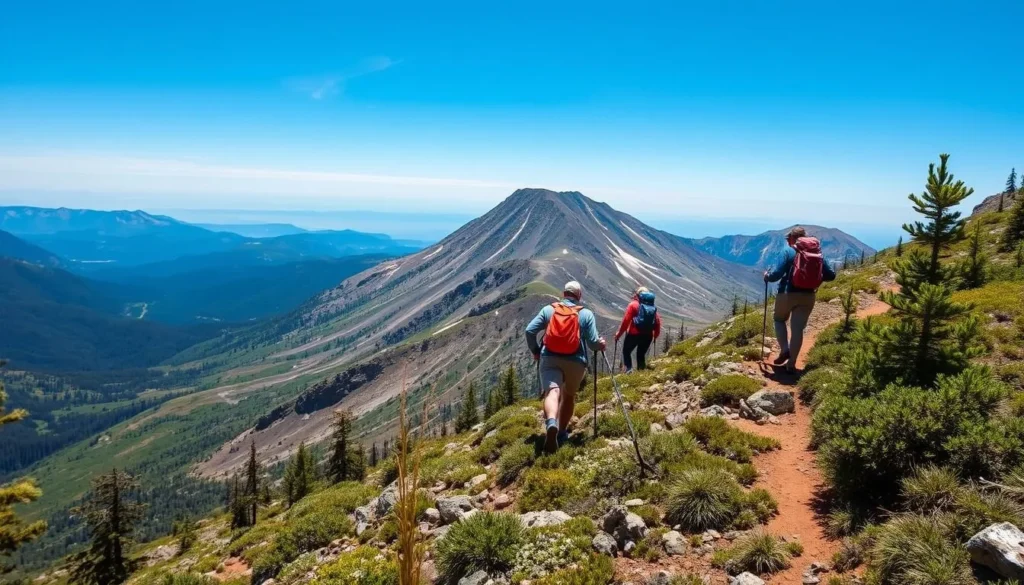
As you prepare to tackle the Lassen Peak Trail, understanding the trail details and what to expect is crucial for a successful summit. The Lassen Peak Trail is a challenging yet rewarding hike that offers breathtaking views of Lassen Volcanic National Park.
Tips for a Successful Summit
The trail begins at a well-marked parking area along the main park highway at an elevation of 8,500 feet. The trail’s surface varies from packed dirt to increasingly rocky and loose volcanic scree as you gain elevation, requiring proper footwear with good ankle support and traction.
You’ll encounter approximately 30 switchbacks along the route, designed to make the steep ascent more manageable. Weather conditions can change rapidly on the mountain, so it’s essential to carry extra layers, rain protection, sun protection, and plenty of water.
The final approach to the summit features a small crater area and several fumaroles that occasionally emit steam, providing a reminder that you’re climbing an active volcano. Many hikers underestimate the effects of high altitude, so pace yourself, take frequent short breaks, and don’t hesitate to turn back if you experience symptoms of altitude sickness.
The summit area offers several protected spots to rest and enjoy a picnic lunch while taking in the panoramic views. Pack some high-energy snacks to refuel before your descent. With its unique volcanic landscape and diverse geological features, hiking to the summit of Lassen Peak is an adventure like no other.
Exploring the Cinder Cone and Painted Dunes
Visitors to Lassen Volcanic National Park can explore the Cinder Cone and Painted Dunes, a duo of natural wonders that showcase the park’s volcanic heritage. The Cinder Cone Trail, located in the northeast part of the park, is a must-visit attraction for its breathtaking views and unique geological features.
The Unique Volcanic Landscape
The Cinder Cone Trail offers an unforgettable adventure amidst a unique volcanic landscape. Formed about 350 years ago, the Cinder Cone is one of the youngest volcanic features in Lassen Volcanic National Park, providing a rare opportunity to explore a relatively recent volcanic formation.
To access the Cinder Cone, visitors must drive to the remote Butte Lake area via a 6-mile unpaved road, adding to the adventure and ensuring fewer crowds. The trail begins with a relatively flat 1.5-mile walk through pine forest and across the Fantastic Lava Beds before reaching the base of the perfectly symmetrical cone.
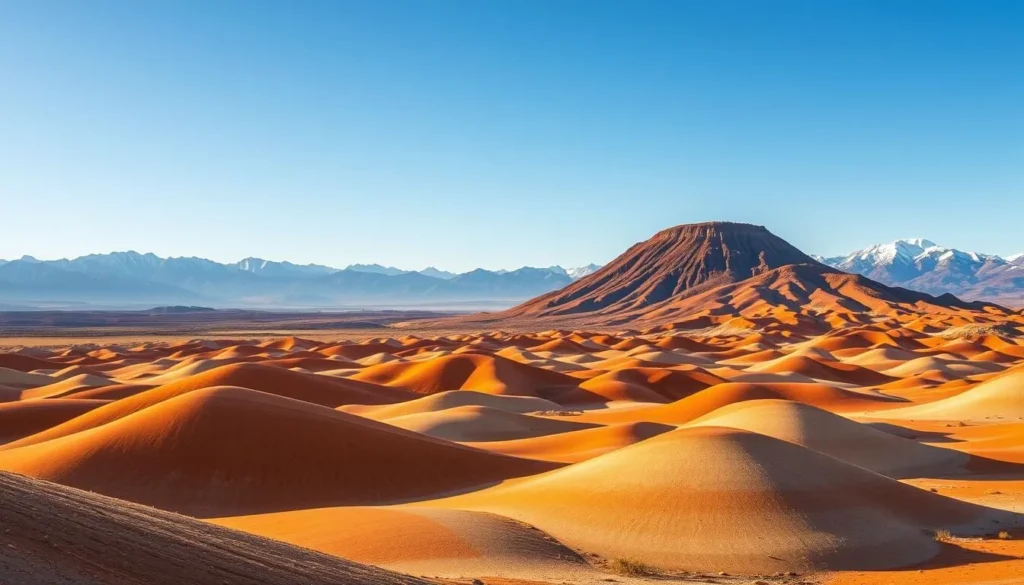
The climb up Cinder Cone is notoriously challenging due to the loose volcanic cinders that give way beneath your feet. However, from the summit rim, you’ll be rewarded with spectacular views of the Painted Dunes, where mineral-rich volcanic ash has created a landscape of vibrant colors.
| Trail Feature | Description |
|---|---|
| Trail Length | 4 miles round trip |
| Elevation Gain | 500 ft (150 m) |
| Best Time to Visit | Sunrise or Sunset for optimal photography |
Inside the cone’s crater, you can descend to explore the perfectly formed bowl and examine the volcanic materials up close. The best times to photograph the Painted Dunes are during early morning or late afternoon when low-angle sunlight enhances the vibrant colors.
Exploring the Cinder Cone and Painted Dunes is an unforgettable experience that highlights the unique volcanic landscape of Lassen Volcanic National Park. Whether you’re a hiker, photographer, or nature enthusiast, this trail offers something for everyone.
Photography Tips for Capturing the Painted Dunes

For photographers, Lassen Volcanic National Park is a treasure trove of opportunities, with the Painted Dunes being a standout attraction. The unique volcanic landscape offers a myriad of photographic possibilities, from the vibrant colors of the dunes to the serene beauty of the park’s numerous lakes.
Breathtaking Lakes of Lassen Volcanic National Park
The park is home to over 200 lakes, each offering unique photographic opportunities and recreational possibilities. From the striking turquoise waters of Lake Helen to the perfect reflections of Lassen Peak at Manzanita Lake, there’s no shortage of breathtaking scenes to capture.
Summit Lake stands out for its excellent swimming opportunities during the summer, making it a favorite among families. Meanwhile, Butte Lake features unique black sand beaches created from volcanic cinders, contrasting dramatically with the clear water and surrounding forest.
Juniper Lake, accessible via a rough unpaved road, rewards visitors with the park’s largest and deepest lake, offering excellent fishing for rainbow and brown trout. Many of the park’s lakes are connected by scenic hiking trails, allowing visitors to create multi-lake itineraries that showcase the diversity of alpine lake environments within a single day’s exploration.
If you’re interested in photographing the vibrant colors of the Painted Dunes, the Cinder Cone Trail is recommended for either sunrise or sunset, as the soft light brings out the best of the colors during these times. Summit Lake is also noteworthy for how beautifully Lassen Peak is lit up during the late evening hours, making it a great spot for capturing stunning sunset views.
The diverse landscapes within Lassen Volcanic National Park provide endless opportunities for photographers. Whether you’re capturing the serene beauty of the lakes or the dramatic landscapes of the Painted Dunes, the park is sure to inspire.
Lake Helen: The Jewel of Lassen
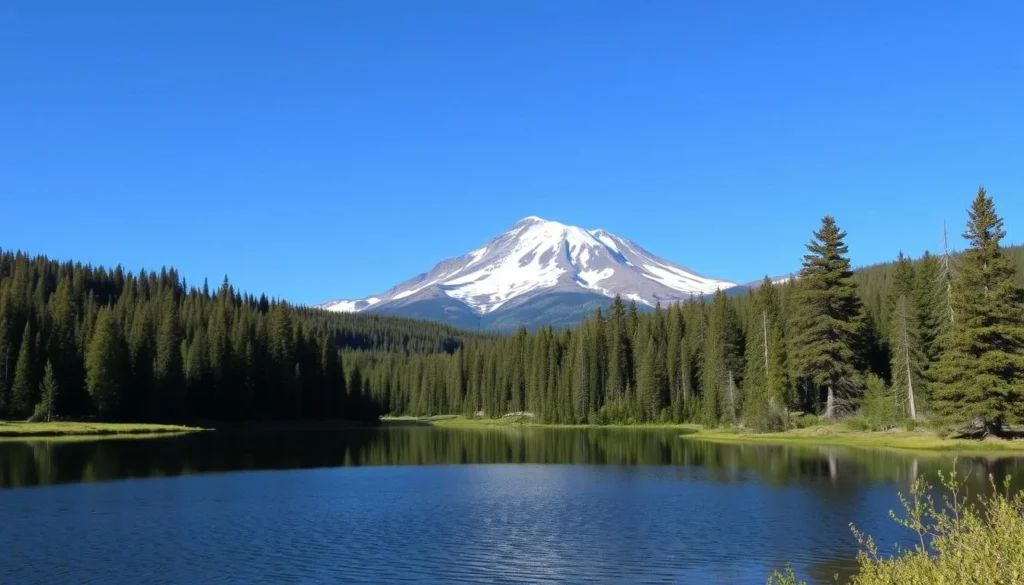
The lakes within Lassen Volcanic National Park offer a tranquil escape amidst the volcanic landscape. Among these, Lake Helen stands out as a breathtaking destination.
Lake Helen sits at an elevation of 8,200 feet, making it one of the highest accessible lakes in the park. Its striking blue-green color is due to the presence of glacial flour and mineral content, creating a visual spectacle that changes throughout the day as light conditions shift.
Manzanita Lake: Recreation and Reflection
Manzanita Lake, located near the northwest entrance of the park, is another gem that offers a range of recreational activities. You can fish on the lake, rent kayaks, or simply enjoy the serene surroundings.
The lake features a flat 1.5-mile loop trail that circles the entire shoreline, offering constantly changing perspectives of Lassen Peak reflected in its waters. The trail is ideal for those looking to enjoy the outdoors and take in the stunning views.
- Lake Helen is often the last to thaw completely, sometimes remaining partially frozen into July.
- The lake was named after Helen Brodt, who in 1864 became the first white woman to climb Lassen Peak.
- Manzanita Lake supports a healthy population of trout, making it popular with anglers.
- The Loomis Museum, located in the Manzanita Lake historic district, houses exhibits on the park’s volcanic history.
Both Lake Helen and Manzanita Lake offer unique experiences, showcasing the natural beauty and diversity of Lassen Volcanic National Park. Whether you’re interested in recreation or simply taking in the views, these lakes are must-visit destinations.
Summit Lake: Perfect for Sunset Views
One of the most stunning experiences in Lassen Volcanic National Park is watching the sunset at Summit Lake, where the sky and water converge in a kaleidoscope of colors. Summit Lake is one of many beautiful alpine lakes within the park, but its unique setting makes it stand out.
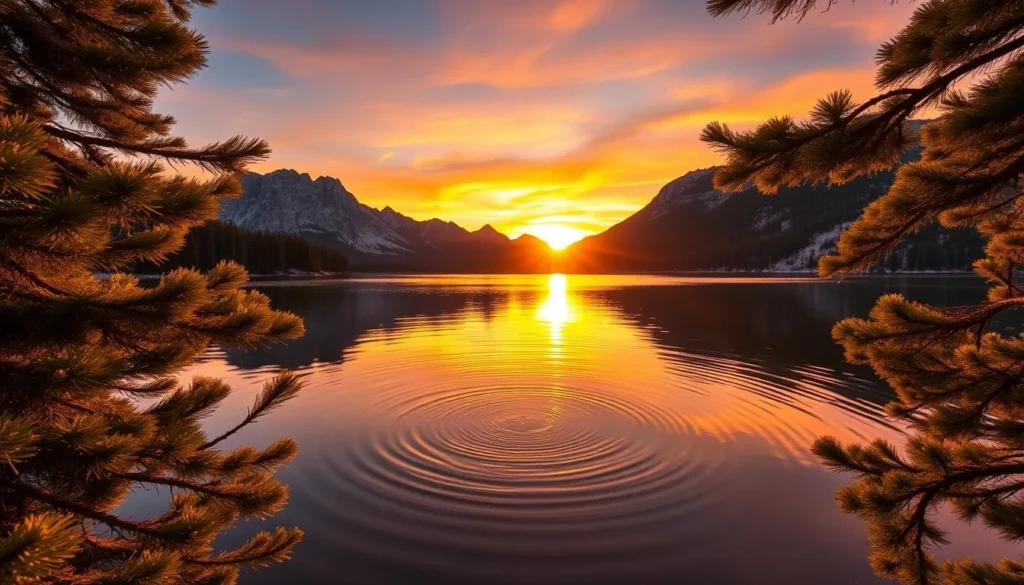
Summit Lake is divided into north and south sections, both offering campgrounds with scenic overnight accommodations. The lake’s location at the midpoint of the park’s main highway makes it an ideal base for exploring attractions in both the northern and southern sections of Lassen Volcanic National Park.
Top Hiking Trails Beyond Lassen Peak
The area around Summit Lake is a hiker’s paradise, with several excellent trails originating from here. The Echo Lake Trail is a moderate 4.2-mile round-trip hike that takes you to a pristine alpine lake nestled in a cirque basin.
- The still waters of Summit Lake create perfect reflections of the surrounding forest and mountains during summer evenings.
- The lake’s relatively warm waters make it popular for swimming, with a small beach area on the north shore ideal for families.
- The Summit Lake area offers excellent stargazing opportunities due to minimal light pollution.
- Wildlife viewing is particularly good around Summit Lake at dawn and dusk.
As you explore the trails around Summit Lake, you’ll be treated to breathtaking views of Lassen Peak and the surrounding landscape. The Summit Lake area is a must-visit destination within Lassen Volcanic National Park, offering a mix of relaxation and adventure.
Whether you’re looking to hike, swim, or simply take in the views, Summit Lake is a perfect spot. As the sun sets, the sky is painted with vibrant colors, making it a truly unforgettable experience in this beautiful national park.
Kings Creek Falls Trail: A Forest Adventure
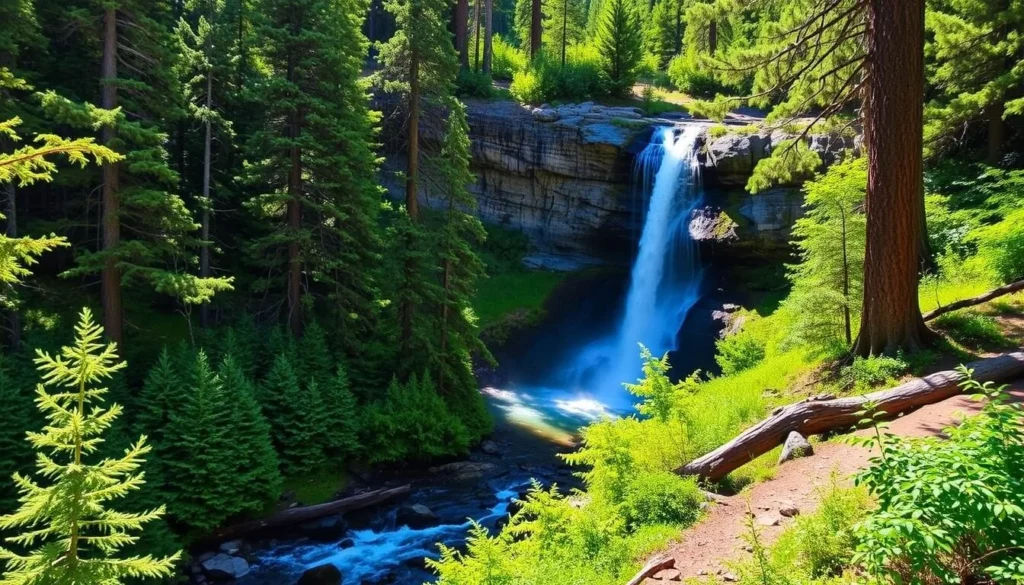
The beauty of Lassen Volcanic National Park lies in its diverse landscapes and trails. One of the most captivating trails is the Kings Creek Falls Trail, a 2.3-mile loop that takes you through a lush forest to a breathtaking 30-foot waterfall.
The trail has its challenges, with rocky and muddy parts, and a steep staircase on the way back down. It’s essential to have hiking poles and good shoes to navigate these sections safely. However, the view of the waterfall, surrounded by greenery, is truly rewarding.
A Trail for Every Hiker
The Kings Creek Falls Trail offers two route options: a steeper, more direct path and a gentler, more gradual descent. This allows hikers to choose based on their ability and preferences. Along the trail, you’ll pass through lush meadows filled with wildflowers in summer, dense forests of red fir and lodgepole pine, and alongside the tumbling waters of Kings Creek.
The 40-foot waterfall at the trail’s highlight point cascades dramatically over volcanic rock, creating a misty environment that supports unique plant life and offers natural cooling on hot summer days.
Prospect Peak Trail: Off the Beaten Path
For those looking for a more challenging hike, the Prospect Peak Trail is one of the least-trafficked trails in Lassen Volcanic National Park. This 7-mile round-trip trail has an elevation gain of 1,800 feet, rewarding hikers with solitude and panoramic views that few park visitors experience.
From Prospect Peak’s 8,338-foot summit, you’ll enjoy a unique perspective of Lassen Peak, Cinder Cone, the Painted Dunes, and on clear days, even distant Mount Shasta to the north. The trail passes through areas affected by recent forest fires, providing an educational opportunity to observe forest regeneration and the role of fire in maintaining healthy ecosystems.
Both the Kings Creek Falls Trail and Prospect Peak Trail offer excellent wildlife viewing opportunities, with chances to spot black-tailed deer, various woodpecker species, and if you’re lucky, the occasional black bear foraging at a safe distance.
Geothermal Wonders: Earth’s Power on Display
One of the park’s most striking features is Bumpass Hell, a vast hydrothermal area filled with boiling mud pots and steaming vents. Located within Lassen Volcanic National Park, Bumpass Hell is a must-visit destination for anyone interested in geothermal features.

The Park’s Largest Hydrothermal Area
Bumpass Hell is the park’s biggest hydrothermal area, named after Kendall Vanhook Bumpass, an early explorer who severely burned his leg after breaking through the thin crust into a boiling mud pot in the 1860s. This incident underscores the importance of staying on designated boardwalks when exploring the area.
The 16-acre hydrothermal area features over 75 geothermal features, including hissing steam vents (fumaroles), bubbling mud pots, and hot springs with water temperatures reaching up to 240°F (116°C). A 3-mile round-trip trail leads visitors to Bumpass Hell, traversing a ridge with spectacular views before descending to the boardwalks that wind through the steaming basin.
- The vibrant colors throughout the area—from bright turquoise pools to rusty orange and yellow mineral deposits—are created by heat-loving bacteria and minerals dissolved in the superheated water.
- The distinct rotten egg smell permeating the area comes from hydrogen sulfide gas, a natural byproduct of the geothermal activity.
- The boardwalk system allows visitors to safely navigate through the area while protecting both the fragile thermal features and visitors from the dangerous hot water and unstable ground.
Bumpass Hell represents just a small surface expression of a much larger hydrothermal system that extends deep underground, connected to the volcanic plumbing system that once fed Lassen Peak’s eruptions. This unique geothermal area is a testament to the earth’s incredible power and beauty, making it a highlight of any visit to Lassen Volcanic National Park.
Sulphur Works and Devil’s Kitchen: Accessible Geothermal Features
You can experience the raw power of geothermal activity at Sulphur Works and Devil’s Kitchen in Lassen Volcanic National Park. These areas offer a unique glimpse into the park’s volcanic activity and dynamic geology.
Sulphur Works is one of the most accessible geothermal areas in the park, located directly alongside the main park highway. A short, wheelchair-accessible pathway leads to viewing areas of bubbling mud pots and steam vents. This area is believed to be part of the ancient Mount Tehama volcano’s main vent, which collapsed thousands of years ago, leaving behind the still-active hydrothermal system we see today.
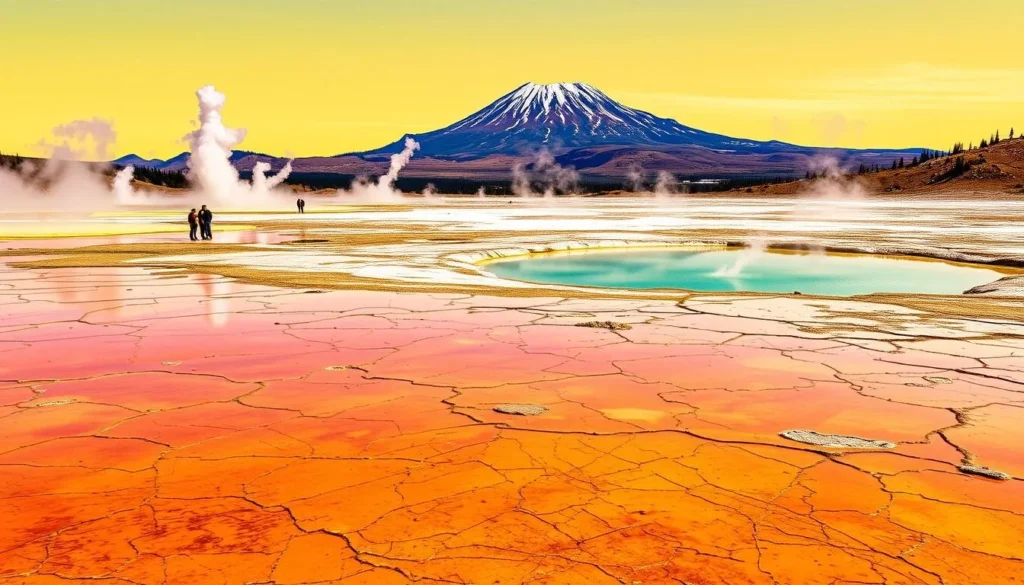
- The distinctive yellow mineral deposits at Sulphur Works are created by elemental sulfur crystallizing around fumarole openings as hot gases cool upon reaching the surface.
- Devil’s Kitchen, accessible via a 4.2-mile round-trip hike in the Warner Valley area, offers a more remote and extensive hydrothermal experience with numerous steam vents, mud pots, and hot springs spread along Hot Springs Creek.
- Unlike Bumpass Hell’s boardwalks, Devil’s Kitchen provides a more natural viewing experience, though visitors must still remain on the designated trail for safety and resource protection.
A Closer Look at Geothermal Wonders
Both Sulphur Works and Devil’s Kitchen demonstrate the park’s ongoing volcanic activity, serving as pressure release valves for the heat and gases generated by magma deep beneath the surface. These accessible geothermal features provide visitors with opportunities to witness firsthand the powerful forces that have shaped the Lassen landscape over thousands of years.
As you explore these geothermal areas, you’ll gain a deeper appreciation for the natural wonders that make Lassen Volcanic National Park so unique. The experience is not only educational but also awe-inspiring, leaving a lasting impression on all who visit.
Tips for Visiting Geothermal Areas
When visiting Sulphur Works and Devil’s Kitchen, be sure to stay on designated trails and follow park guidelines to ensure a safe and enjoyable experience. The geothermal features in Lassen Volcanic National Park are a testament to the Earth’s incredible power and beauty.
Dark Sky Viewing Locations
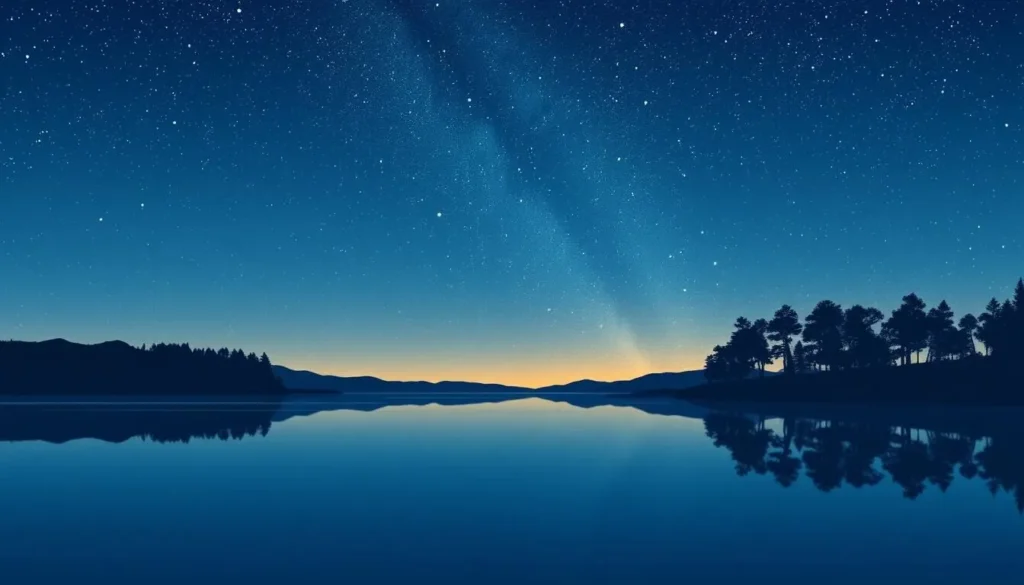
Lassen Volcanic National Park is renowned for its incredible dark skies, making it an ideal destination for stargazing enthusiasts. The park’s remote location and high elevation result in minimal light pollution, allowing visitors to see thousands of stars clearly.
The park offers several prime locations for dark sky viewing. Manzanita Lake is one of the top spots, providing unobstructed views of the night sky reflected in its still waters. The Bumpass Hell parking area is another premier location, offering panoramic views of the night sky above the mountain landscape.
Celebrating the Night Sky: Annual Events
The annual Lassen Dark Skies Festival is a highlight for star lovers, featuring special astronomy presentations, solar viewing opportunities, and nighttime telescope stations staffed by knowledgeable astronomers. The festival includes activities for all ages, from children’s astronomy crafts to advanced astrophotography workshops.
Timing your visit to coincide with major meteor showers, such as the Perseids in August, can enhance your stargazing experience. The park also hosts ranger-led stargazing programs during the summer months, where experts point out constellations, planets, and deep-space objects visible through telescopes.
Whether you’re an avid astronomer or just looking for a unique experience, Lassen Volcanic National Park’s dark skies offer an unforgettable adventure. So pack your binoculars and enjoy the celestial display that this incredible national park has to offer.
Where to Stay: Accommodation Options
From camping under the stars to relaxing in cozy resorts, Lassen Volcanic National Park has accommodation options for everyone. Whether you’re looking for an adventurous camping experience or a comfortable stay, the park and its surrounding areas offer a variety of choices to suit your needs.
Camping Within the Park
Lassen Volcanic National Park features seven campgrounds with over 400 total sites, ranging from developed facilities with flush toilets to more primitive options with vault toilets and no running water. You can choose from several campgrounds, each offering a unique experience.
Popular Campgrounds:
- Manzanita Lake Campground: With 179 sites, it’s the park’s largest campground and offers the most amenities, including flush toilets, potable water, a camp store, and kayak rentals, making it ideal for families and first-time campers.
- Summit Lake Campgrounds (North and South): These provide stunning lakeside camping with swimming access and are centrally located within the park, offering easy access to attractions in both the northern and southern areas.
- Butte Lake Campground: Located in the northeast corner, it offers a more secluded experience with 101 sites nestled among pine trees near the lake and provides the closest access to Cinder Cone and Painted Dunes.
- Warner Valley Campground: With just 18 sites, it offers a quiet, primitive camping experience near Devil’s Kitchen and Boiling Springs Lake, perfect for those seeking solitude.
For those who prefer not to camp, Drakesbad Guest Ranch in the Warner Valley area offers the park’s only lodging with rustic cabins, a dining hall serving family-style meals, and access to a naturally heated swimming pool.
All campgrounds within the park operate on a reservation system through Recreation.gov, with reservations opening six months in advance and filling quickly for summer weekends and holidays. Planning ahead is essential to secure your preferred accommodation.
By choosing the right accommodation, you can enhance your experience in Lassen Volcanic National Park and enjoy all that it has to offer, from its stunning natural beauty to its unique geological features.
The above is subject to change.
Check back often to TRAVEL.COM for the latest travel tips and deals.
